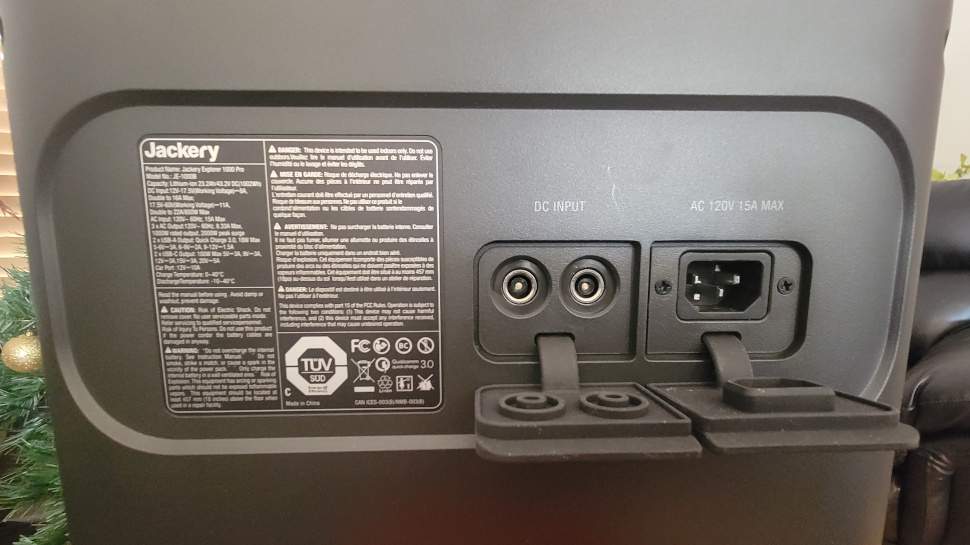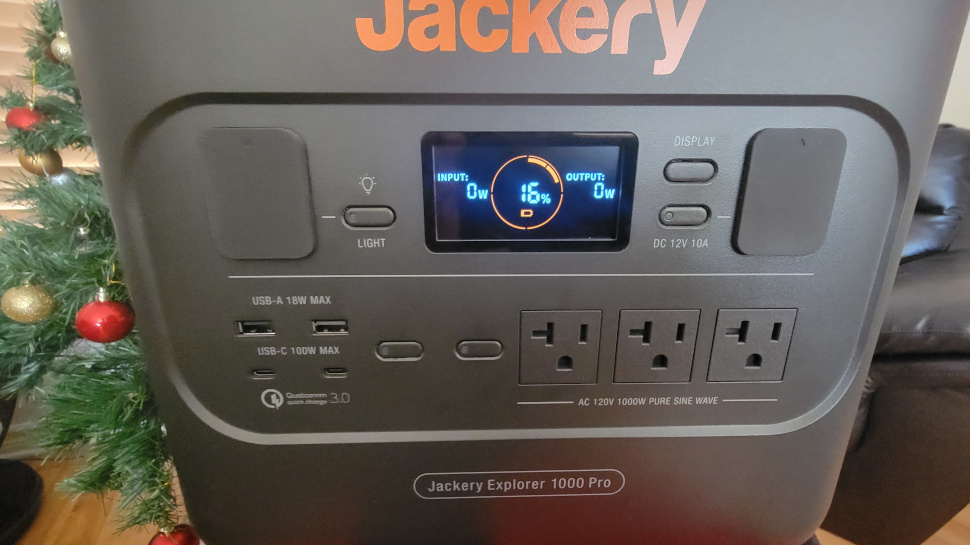TechRadar Verdict
With the Solar Generator 1000 Pro, Jackery offers a compact and powerful power station that can act as a solar generator or an office UPS. The dual solar input, improved battery quality, and fast charging bring it on par, if not better than what the competition offers.
Pros
- +
Upgrade battery life
- +
Integrated AC charger
- +
UPS mode
- +
Power saving
Cons
- -
Efficiency at 85%
Why you can trust TechRadar
The Jackery Solar Generator 1000 is the compact version of the highly popular portable power station, the Jackery Solar Generator 2000, offering an identical display and output sockets in a smaller package. The battery power and AC inverter are reduced to 1000Whr and 1000W, respectively. Compared to the Explorer 1000 that it replaces, the Generator 1000 doubles the number of charge cycles and integrates an AC charger.
The charging power plug and solar panel inputs are at the back, leaving the front panel clutter-free when using multiple AC sockets. Single-purpose push buttons activate each output section, while a two-inch LCD provides information to the user.
Jackery Solar Generator 1000 Pro: Price and availability
The Jackery Solar Generator starts at $1100, the same price point as the previous generation's 1kW power station. It is available as a bundle with either two 80W or four 200W solar panels for $1600 and $4000, respectively.

Jackery Solar Generator 1000 Pro: Design
The Explorer 1000 Pro station can be bought either as a standalone unit or with solar panels. Accessories include a car charger cable, AC cable, two DC adapters to connect solar panels, and a quick start guide. The plastic case measures 34cm x 26.2cm x 25.5cm and weighs about 11.5kg. A built-in handle lays perfectly flat when not needed, while four rubber pads on the bottom act as feet and hold the station in place.
The new Jackery station is very simple to use, with outputs turned on or off through push buttons. Each button has a green LED embedded in the plastic cap that lights up when pressed. The front panel has five distinct sections, a 3” LCD screen showing the station's parameters, AC and DC outputs, a LED flashlight, and a 12V car port.
The Explorer 1000 Pro sports three 1000W AC outputs, capable of a 2000W surge for a few seconds. Exceeding the output power capacity triggers the overcurrent protection, and the only way to recover is to remove all loads and power cycle the station. The DC sections support Type-C and Type-A USB sockets with two 100W Type-C with PD and two Type-A capable of 18W max. A car lighter socket completes the DC low-voltage section, providing up to 120W at 12V.
The back of the Jackery station holds input sockets to charge the unit. The charging section has a maximum input power of 800W through two solar ports or one AC input, resulting in a full charge in under two hours. The unit defaults to solar when both inputs are connected. Car charging through the provided cable is the slowest method, completing a full charge in about ten hours.

Jackery Solar Generator 1000 Pro: In use
Thanks to its minimalist interface, using the Jackery Explorer 1000 Pro is straightforward. Every button activates the LCD, which turns off automatically after 30 seconds. The unit can turn itself off when no output devices are connected to save power. Pressing a few seconds on the Display button will disable the automatic turn-off when not needed.
A multi-function flashlight is accessible on the front. The white LED supports two intensities, a 1W, and a 3W, while also offering an SOS mode. The SOS mode is excellent in case of an emergency on the road and will blink the LED at a one-second interval.
The Explorer 1000 Pro has an overall efficiency of 85%, meaning that for every kilowatt entering the station, only 850W is available to the user, with the remaining power producing heat and turning the fans. The NMC battery cell offers more than 1000 charge cycles before experiencing a 20% capacity drop, an improvement from the last generation, which provided only 500 charge cycles.
The Explorer supports solar charging through two DC8020 connectors located on the back. The socket size is specific to Jackery and requires using the included adapter to mate to other non-Jackery panels. The charger maximizes efficiency using the MTTP algorithm, and each DC input can accept a maximum voltage of 60V at 11A, resulting in a minimum charge time of under two hours.
Jackery Solar Generator 1000 Pro: The competition
Power stations in the 1kW range are easy to get online due to countless crowdfunding campaigns that have spawned many good products. Jackery has built an excellent reputation through great online support and easy-to-use stations. Compared to previous Explorer generations, the improved cell quality and new features, such as a UPS mode and fast charging, are game changers.
The recently launched Anker 757 is an excellent power station, offering similar battery and inverter performance as the Explorer 1000 pro. It is more pricey than the Jackery and slightly heavier, while the 300W solar input is less than a third of what the Jackery unit can accept.
Jackery Solar Generator 1000 Pro: Final verdict
The Jackery Explorer 1000 Pro fits well in the shoes of the Explorer 1000 with plenty of features that will please potential buyers. The longer-life battery, integrated AC charging, and UPS mode are just a few items that will convince you to get one. The two DC inputs for solar charging are also handy, connecting to twice as many solar panels as the previous version.
The Explorer 1000’s main disadvantages are the non-standard DC solar input and an 85% overall efficiency, similar to the previous version. The price of the station is also more than the competition. That said, the user gets a three-year warranty with two additional years when registering online.
My interest has been piqued by everything electronic since a young age, with a penchant for the dark art of tearing things apart. My daily duty is to marry software and hardware modules and I have to admit that this is much harder than cooking. When I’m not busy at work, I’m on the lookout for the latest and greatest hack! I am passionate about portable power generators (or power stations) as well as maker products such as the Raspberry Pi and any similar SBC (single board computers)

